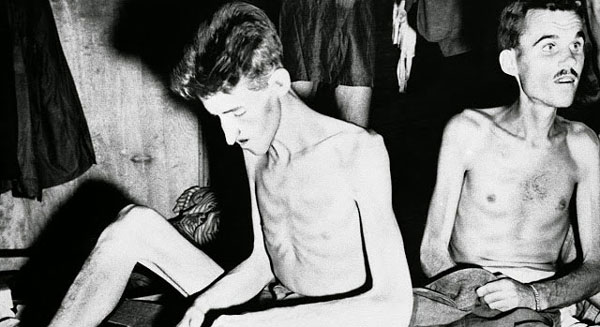End of the war: Huge parts of Europe and Asia had been reduced to ruins. Homecomings and burials were under way. Massive efforts to build and rebuild had just begun. Here are 40 incredible photos of the aftermath of World War II.
German Wehrmacht General Anton Dostler, Commander of the 75th Army Corps, was sentenced to death by an U. S. Military Commission in Rome for having ordered the shooting of 15 unarmed American prisoners of war on March 26, 1944. He’s tied to a stake before his execution by a firing squad in Aversa, Italy, on December 1, 1945.
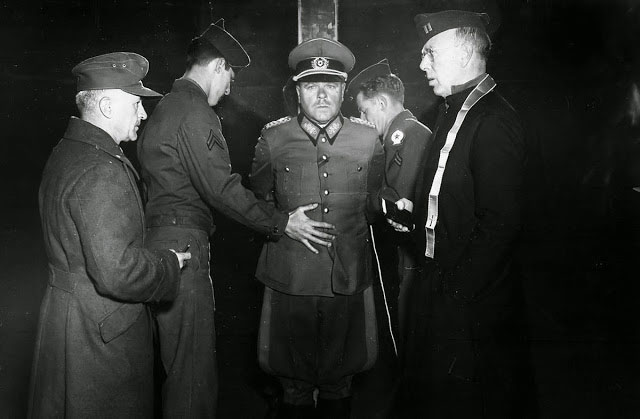
AP Photo
Soviet soldiers with lowered standards of the defeated Nazi forces during the Victory Day parade in Moscow, on June 24, 1945.

Yevgeny Khaldei/Waralbum.ru
Two gaunt and emaciated but happy allied prisoners at their release from Japanese captivity, near Yokohama, Japan, on September 11, 1945.

AP Photo
The return of victorious Soviet soldiers at a railway station in Moscow in 1945.

Arkady Shaikhet/Waralbum.ru
A Japanese man amid the scorched wreckage and rubble that was once his home in Yokohama, Japan.

NARA
Red Army photographer Yevgeny Khaldei (center) in Berlin with Soviet forces, near the Brandenburg Gate in May of 1945.

Waralbum.ru
A P-47 Thunderbolt of the U.S. Army 12th Air Force flying low over the crumbled ruins of what once was Hitler’s retreat at Berchtesgaden, Germany, on May 26, 1945. Bomb craters dot the grounds around the wreckage.
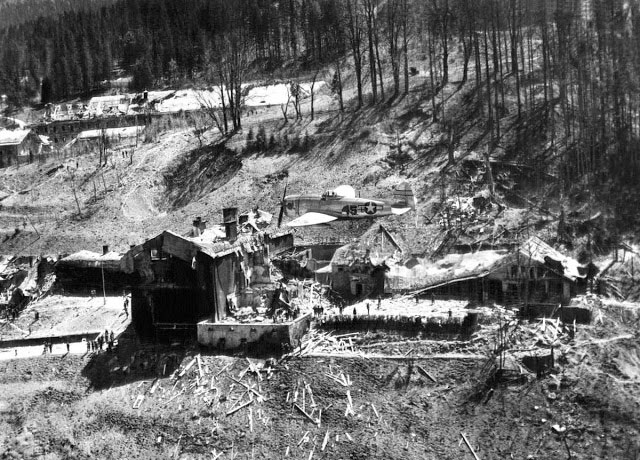
AP Photo
The Heinkel He-162 Volksjaeger, one of the captured new and experimental German aircraft, displayed in an exhibition in Hyde park, London on September 14, 1945.
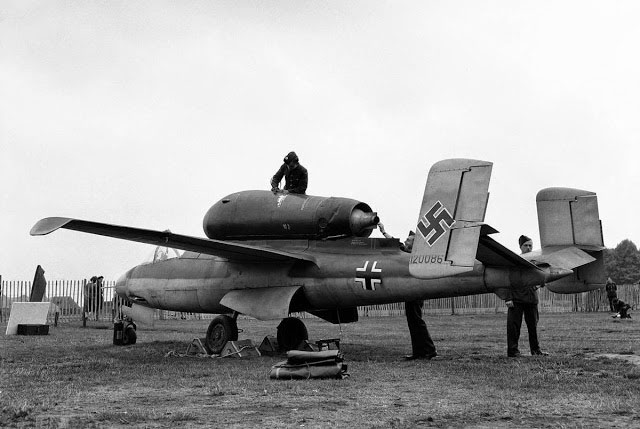
AP Photo
One year after the D-Day landings in Normandy, German prisoners landscape the first U.S. cemetery at Saint-Laurent-sur-Mer, France, near “Omaha” Beach, on May 28, 1945.
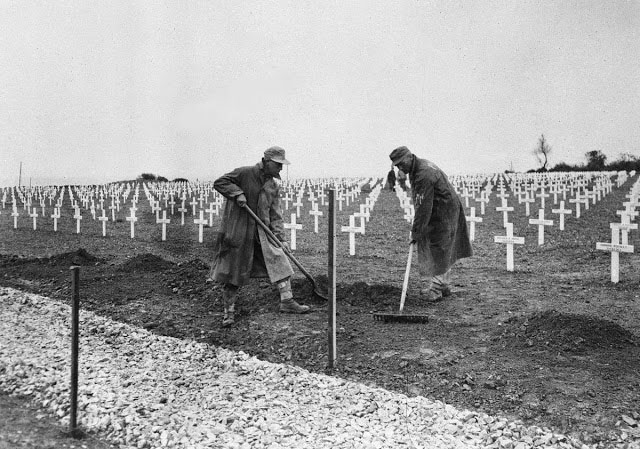
AP Photo/Peter J. Carroll
Sudeten Germans making their way to the railway station in Liberec, in former Czechoslovakia, to be transferred to Germany in this July, 1946 photo. Millions of German nationals and ethnic Germans were forcibly expelled from formerly German lands. An estimate of between 500,000 and 2 million Germans died during the expulsion.
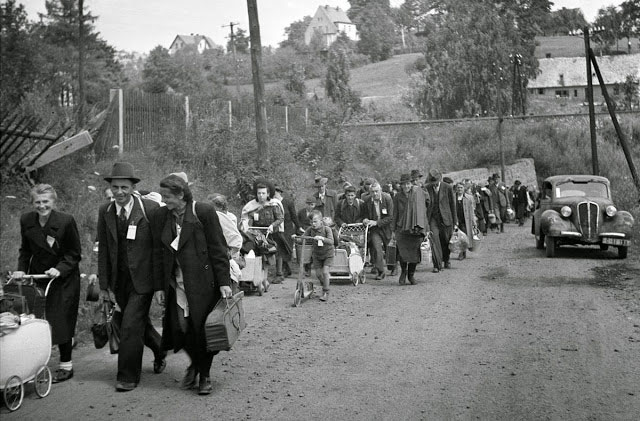
AP Photo/CTK
Disabled buses littered the streets of Tokyo. They were later used to help relieve the acute housing shortage in the Japanese capital on October 2, 1946.

AP Photo/Charles Gorry
American G.I. placing his arm around a Japanese girl as they view the surroundings of Hibiya Park, near the Tokyo palace of the emperor, on January 21, 1946.
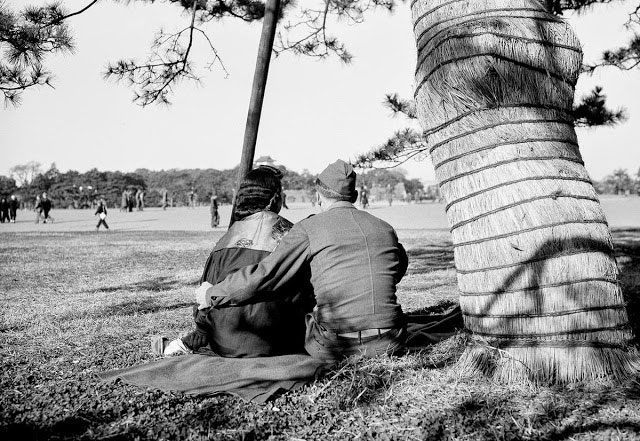
AP Photo/Charles Gorry
Aerial view of the city of London around St. Paul’s Cathedral showing bomb-damaged areas in April of 1945.

AP Photo
General Charles de Gaulle shaking hands with children two months after the German capitulation in Lorient, France, in July of 1945. Lorient was the location of a German U-boat (submarine) base during World War II. Between January 14 and February 17, 1943, as many as 500 high-explosive aerial bombs and more than 60,000 incendiary bombs were dropped on Lorient. The city was almost completely destroyed, with nearly 90% of the city flattened.
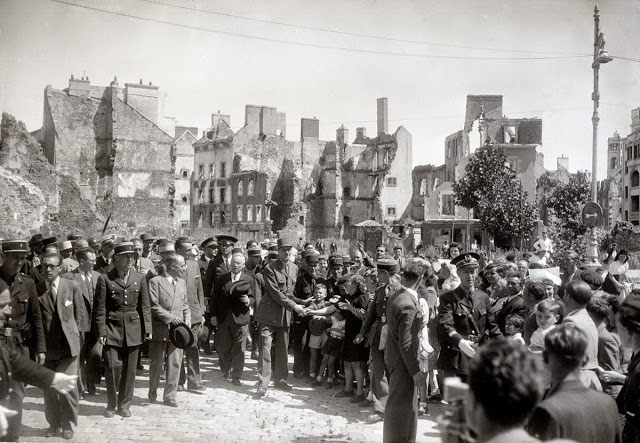
AFP/Getty Images
The super transport ship, General W.P. Richardson, docked in New York, with veterans of the European war cheering on June 7, 1945.

AP Photo/Tony Camerano
Aerial photo Levittown, New York, in 1948 shortly after the mass-produced suburb was completed on Long Island farmland in New York. This prototypical suburban community was the first of many mass-produced housing developments that went up for soldiers coming home from World War II.

AP Photo/Levittown Public Library, File
This television set, retailing for $100, is reportedly the first moderately priced receiver manufactured in quantity. It reproduces a 5×7 image. Although television was invented prior to World War II, the war prevented mass production. Soon after the war, sales and production picked up, and by 1948, regular commercial network programming had begun.
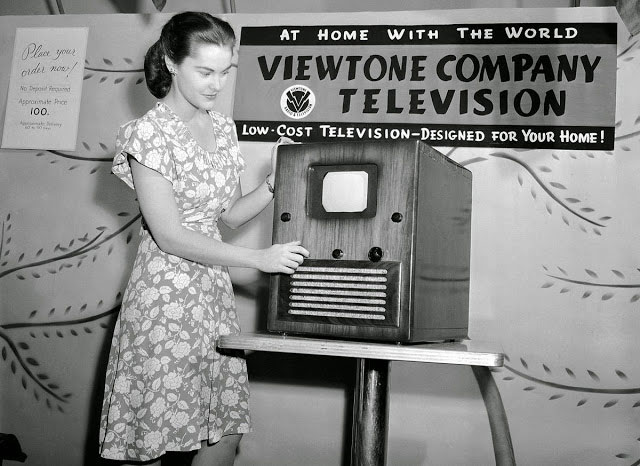
AP Photo/Ed Ford
A U.S. soldier examines a solid gold statue, part of Hermann Goering’s private loot, found by the 7th U.S. Army in a mountainside cave near Schonau am Konigssee, Germany, on May 25, 1945. The secret cave, the second found to date, also contained stolen priceless paintings from all over Europe.

AP Photo/Jim Pringle
In Europe, some churches have been completely ruined, but others still stand amid utter devastation. Munchengladbach Cathedral stands here in the rubble, though still in need of repairs, seen in Germany, on November 20, 1945.
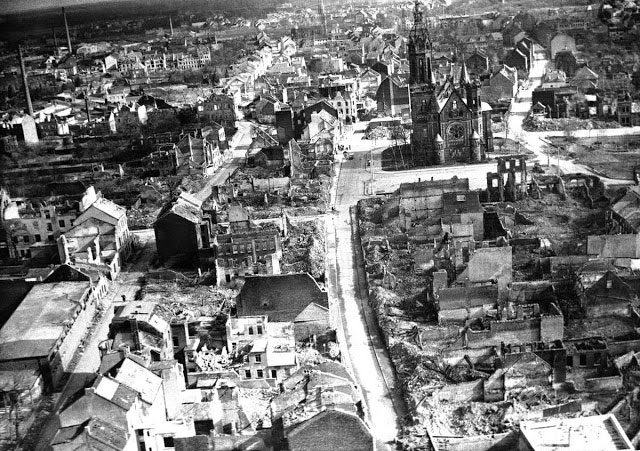
AP Photo
On May 21, Colonel Bird, Commandant of Belsen Camp, gave the order for the last hut at Belsen Concentration Camp to be burned. A rifle salute was fired in honor of the dead, the British flag was run up at the same moment as a flame-thrower set fire to the last hut. A German flag and portrait of Hitler went up in flames inside the hut in June of 1945.

AP Photo/British Official Photo
German mothers walk their children to school through the streets of Aachen, Germany, on June 6, 1945, for registration at the first public school to be opened by the U.S. military government after the war.
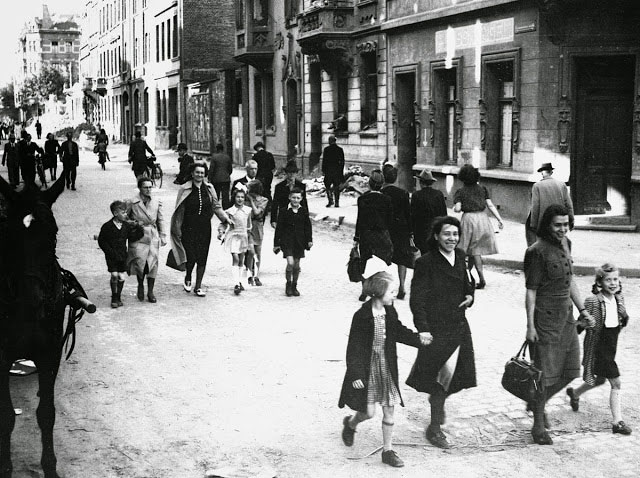
AP Photo/Peter J. Carroll
A general view of the International Military Tribunal for the Far East meeting in Tokyo in April, 1947. On May 3, 1946, the Allies began the trial of 28 Japanese civilian and military leaders for war crimes. Seven were hanged and others were sentenced to prison terms.

AP Photo
Soviet soldiers on the march in northern Korea in October of 1945.
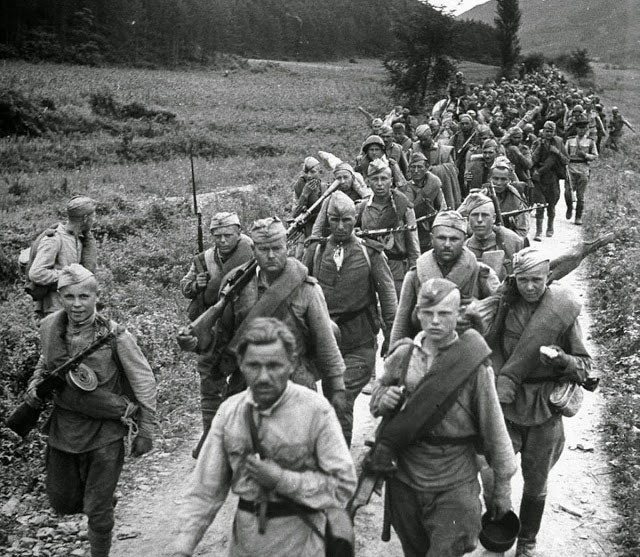
Communist leader Kim Il Sung chats with a farmer from Qingshanli, Kangso County, South Pyongyang in North Korea, in this October 1945 photo.
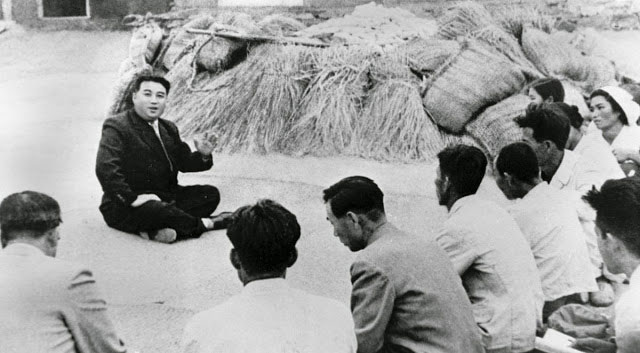
Korean Central News Agency/Korea News Service via AP Images
Soldiers of the Chinese communist Eighth Route Army on the drill field at Yanan, capital of a huge area in North China, which is governed by the Chinese Communist Party, on March 26, 1946. These soldiers are members of the “Night Tiger” battalion.

AP Photo
This 1946 photograph shows ENIAC (Electronic Numerical Integrator And Computer), the first general purpose electronic computer – a 30-ton machine housed at the University of Pennsylvania. Developed in secret starting in 1943, ENIAC was designed to calculate artillery firing tables for the United States Army’s Ballistic Research Laboratory.
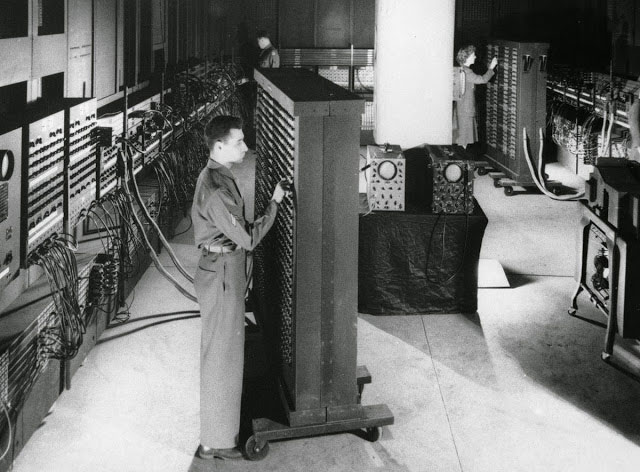
AP Photo
A test nuclear explosion codenamed “Baker,” part of Operation Crossroads, at Bikini Atoll in the Marshall Islands, on July 25, 1946. The 40 kiloton atomic bomb was detonated by the U.S. at a depth of 27 meters below the ocean surface, 3.5 miles from the atoll. The purpose of the tests was to study the effects of nuclear explosions on ships. 73 ships were gathered to the spot — both obsolete American and captured ships, including the Japanese battleship “Nagato.”
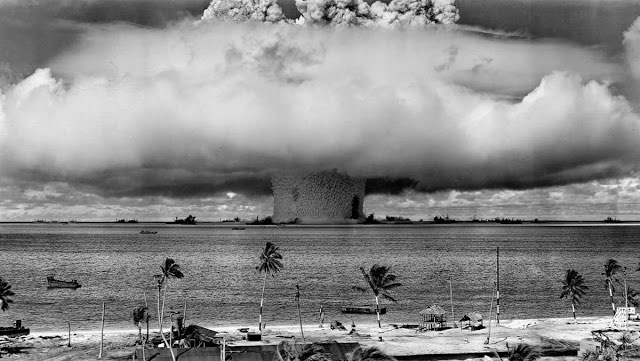
NARA
Japanese ammunition being dumped into the sea on September 21, 1945. During the U.S. occupation, almost all of the Japanese war industry and existing armament was dismantled.
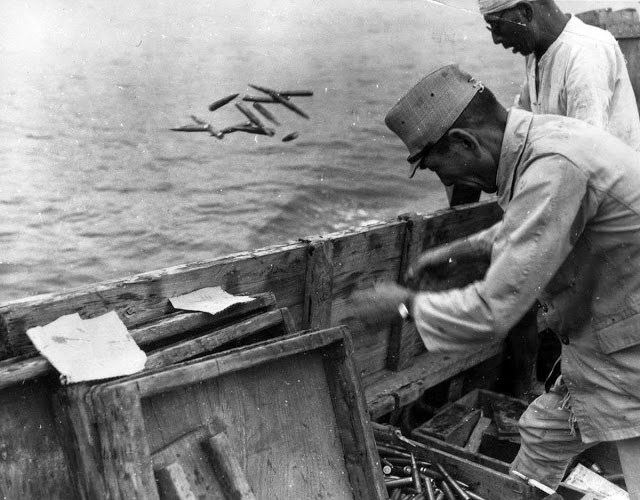
U.S. Army
These unidentified German workers in Decontamination clothing destroy toxic bombs on June 28, 1946, at the U.S. Army Chemical Warfare Service Depot, at St. Georgen, Germany. The destruction and disposal of 65,000 dead weight tons of German toxics, including mustard gas, was accomplished in one of two ways: burning or dumping the empty shells and bombs into the North Sea.
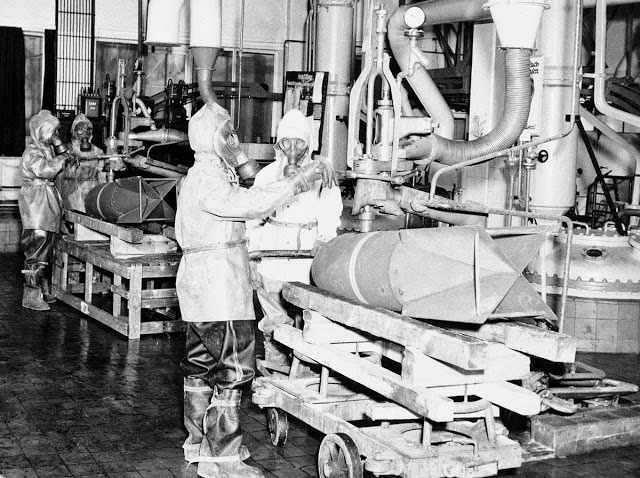
AP Photo
U.S. military authorities prepare to hang Dr. Klaus Karl Schilling, 74, at Landsberg, Germany, on May 28, 1946. In a Dachau war crimes trial he was convicted of using 1,200 concentration camp prisoners for malaria experimentation. Thirty died directly from the inoculations and 300 to 400 died later from complications of the disease. His experiments, all with unwilling subjects, began in 1942.

AP Photo/Robert Clover
The new cemetery at Belsen, Germany on March 28, 1946, where 13,000 people who died after Belsen Concentration Camp was liberated are buried.

AP Photo
Jewish survivors of the Buchenwald Nazi concentration camp stand on the deck of the refugee immigration ship Mataroa, on July 15, 1945 at Haifa port, during the British Mandate of Palestine, in what would later become the State of Israel.

Zoltan Kluger/GPO via Getty Images
Some of Poland’s thousands of war orphans at the Catholic Orphanage in Lublin, on September 11, 1946, where they are being cared for by the Polish Red Cross. Most of the clothing, as well as vitamins and medicines, are provided by the American Red Cross.
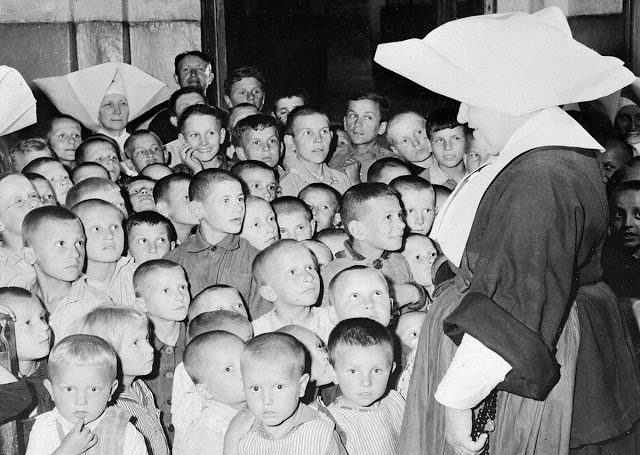
AP Photo
The Empress of Japan visits a Catholic Orphanage staffed by Japanese Nuns for children who have lost their parents in the war and air raids over Tokyo, on April 13, 1946.
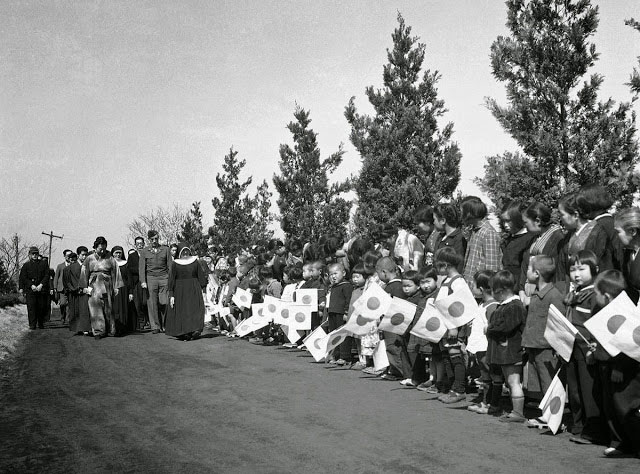
AP Photo
New buildings rise out of the ruins of Hiroshima, Japan, on March 11, 1946. These single story homes built along a hard-surfaced highway are part of the program by the Japanese government to rebuild devastated sections of the country.
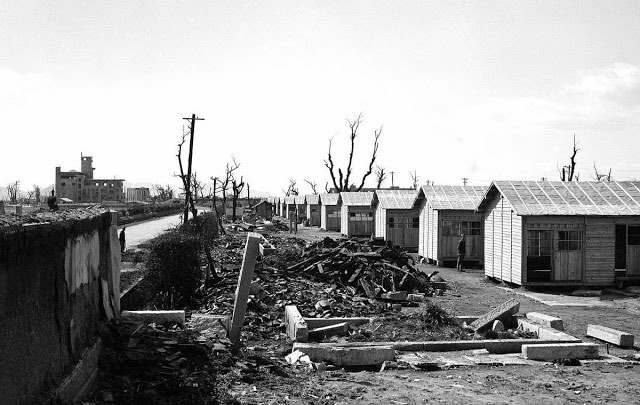
AP Photo/Charles P. Gorry
Clocks are being readied for export to Allied countries, shown as collateral for imported goods needed by Japan. Thirty-four Japanese factories produced 123,000 clocks during April of 1946 (June 25, 1946).
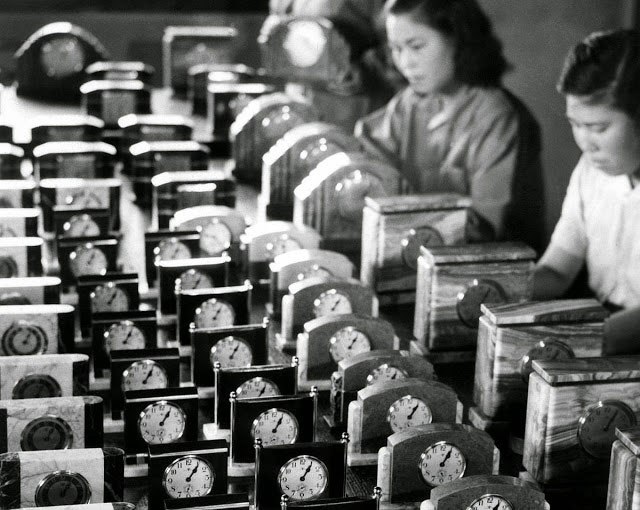
AP Photo/Charles Gorry
U.S. General George S. Patton acknowledges the cheers of thousands during a parade through downtown Los Angeles, California, on June 9, 1945.
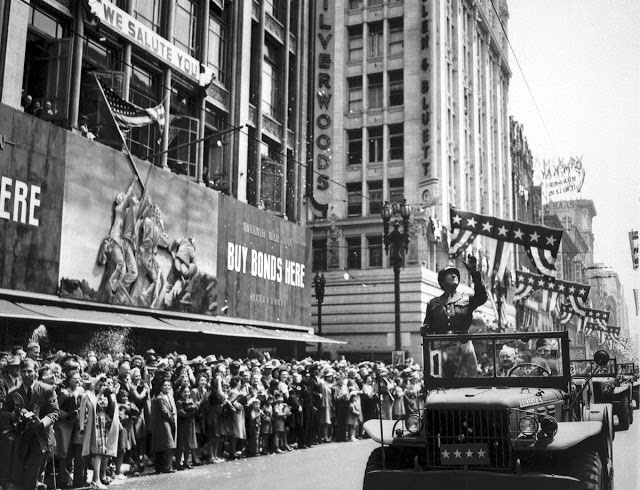
AP Photo
German women clearing up the debris on Berlin’s Tauentzienstrasse, with the ruins of the Kaiser Wilhelm Church in the background. The absence of able bodied men meant that the responsibility for clearing the wreckage fell mainly to civilian women, which were called “Truemmerfrauen,” or rubble ladies.

AP Photo
The scene in Berlin’s Republic Square, before the ruined Reichstag Building, on September 9, 1948, as Anti-Communists, estimated at a quarter of a million, scream their opposition to Communism.

AP-Photo
In March of 1974, some 29 years after the official end of World War II, Hiroo Onoda, a former Japanese Army intelligence officer, walks out of the jungle of Lubang Island in the Philippines, where he was finally relieved of duty. He handed over his sword (hanging from his hip in photo), his rifle, ammunition and several hand grenades. Onoda had been sent to Lubang Island in December of 1944 to join an existing group of soldiers and hamper any enemy attacks. Allied forces overtook the island just a few months later, capturing or killing all but Onoda and three other Japanese soldiers. The four ran into the hills and began a decades-long insurgency extending well past the end of the war. Several times they found or were handed leaflets notifying them that the war had ended, but they refused to believe it. In 1950, one of the soldiers turned himself in to Philippine authorities. By 1972, Onoda’s two other compatriots were dead, killed during guerrilla activities, leaving Onoda alone. In 1974, Onoda met a Japanese college dropout, Norio Suzuki, who was traveling the world, and through their friendship, Onoda’s former commanding officer was located and flew to Lubang Island to formally relieve Onoda of duty, and bring him home to Japan. Over the years, the small group had killed some 30 Filipinos in various attacks, but Onoda ended up going free, after he received a pardon from President Ferdinand Marcos.

AP Photo

